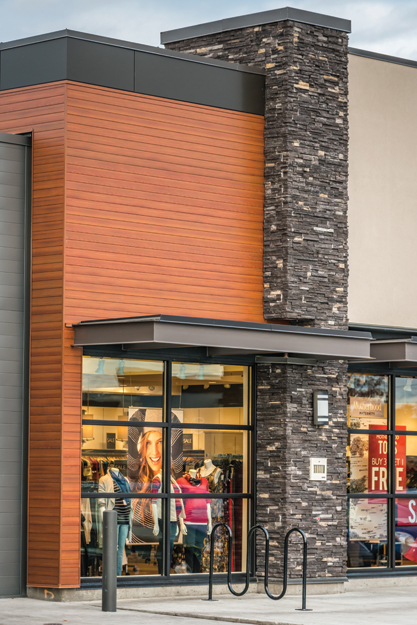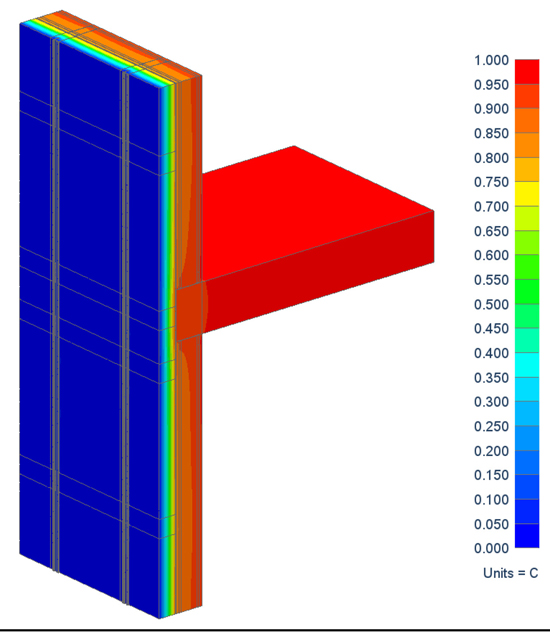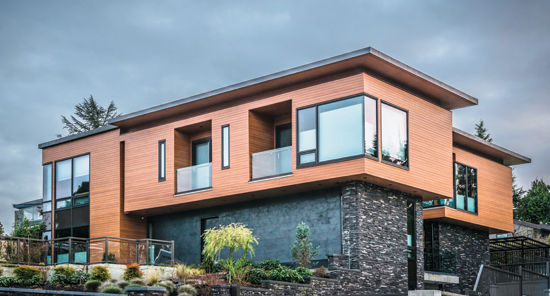Innovations in Aluminum Cladding Systems
The Drive Towards Energy Reduction
Energy use in a building is directly related to the design of the building envelope, and often to the design of the exterior walls in particular. Common wall construction systems suffer from the classic problem of thermal imperfections where insulation material is interrupted by wall framing, floor slabs, corner conditions, or any number of other construction items. These interruptions create “thermal bridges” between the inside and outside which effectively reduce the overall thermal performance of the wall. For example, a conventional stud framed wall that uses insulation between the studs may carry a manufacturer's “nominal” R-value rating of R-19. However, the other materials in the assembly can have a much lower or negligible R-value and account for as much as 20 percent of the total wall surface. The result is an “effective” R-value for the total wall that is closer to R-10 or even less, meaning the wall is less effective thermally and the building will likely need more energy to operate.

Photo by Dale Klippenstein
Aluminum cladding with wood grain appearance can be used effectively on commercial buildings.
The International Energy Conservation Code (IECC) and ASHRAE 90.1 have become the most recognized standards in North America for identifying minimum conditions for energy use reductions in buildings. Both standards recognize the negative impact of thermal bridging on a building's energy performance. Therefore, these standards encourage and sometimes require that these negative effects be mitigated through the use of continuous insulation (ci) to demonstrate code compliance. Specifically, ASHRAE 90.1 defines continuous insulation as “insulation that is continuous across all structural members without thermal bridges other than fasteners and service openings. It is installed on the interior, exterior, or is integral to any opaque surface of the building envelope.” As a practical matter, continuous insulation is commonly installed between the exterior wall sheathing (or comparable surface) and the final exterior cladding or finish material. In so doing, the ci avoids most other construction items and supplies the needed unbroken layer of insulation across the entire wall assembly. Of course, it is up to local jurisdictions to adopt specific versions of energy codes, so details and requirements can and do vary somewhat depending on the location of any particular building. Nonetheless, green building rating systems and other initiatives that seek to achieve energy performance beyond code-required minimums, also recognize and actively promote the effective use of continuous insulation to the fullest extent.
Incorporating continuous insulation on the outside of conventionally framed wall systems has a dramatic effect on the thermal performance of that wall assembly. But the effectiveness of continuous insulation becomes even more pronounced on multistory buildings where a stud wall assembly is used on multiple floors. The studs commonly rest on and get anchored to a floor structure that, for example, could be made from 4 to 6 inches of concrete in a metal deck or from a 10-inch to 12-inch wood framed structure. In this type of construction, the insulation in the wall studs stops above and below the floor structure meaning the floor edge is exposed along the full length and width of the building. The floor becomes a very significant thermal bridge since there is often nothing to prevent heat from being transferred between the inside and the outside of the building along the entire perimeter of the floor construction. The obvious means to overcome this deficiency is to insulate this edge as part of the overall continuous insulation scheme of the building envelope.

Image courtesy of Longboard – a division of Mayne Coatings Corp.
Thermal imaging shows that continuous insulation across an exterior wall and the edge of a floor slab can be extremely effective.
The same type of thermal bridging phenomenon occurs elsewhere in the building envelope as well. Structural elements such as columns or beams made of steel or concrete can create very significant thermal breaks if they are not fully insulated. This applies not only to walls but to roof elements too, such as roof parapets which can act in the vertical plane the same way exposed floor slabs act in a horizontal plane. The ideal solution is to make sure that continuous insulation connects at all of the critical junctures between building assemblies such as the wall and roof junction, parapets, soffits, and fascia.
The Role of Aluminum
Aluminum has been produced commercially for about a century, offering a number of advantages as a building material. Malleable and ductile, it machines and casts easily, offers superior resistance to corrosion, and is about one third the weight of steel and copper. Aluminum is also a low-maintenance, highly durable material. Aluminum's structural strength and stability is consistently high, even under extreme conditions and temperature changes. Where plastics may become brittle at low temperatures, aluminum actually becomes even stronger at extremely cold temperatures, which is why NASA chooses it for many aerospace applications. According to the Aluminum Association, aluminum is 34 times stronger than vinyl, 43 times stronger than wood, and when appropriately alloyed and treated, can be stronger than some steels.
Aluminum is also valued for its recyclability. According to the Aluminum Association, a 2008 survey of producers found an 85 percent recycled content rate for U.S. flat rolled products for the building industry, with some 60 percent from post-consumer sources. Individual producers may be able to provide aluminum with higher percentages. At the end of its service life, many aluminum construction elements can be recycled into like products without a loss in quality. From an energy standpoint, the recycling process only requires 5 percent of the energy used to produce the metal from its origin as bauxite ore. Recycling 1 ton of aluminum, in fact, saves 4 tons of bauxite with associated reductions in air pollution of 95 percent and water pollution by 97 percent.

Photo by Dale Klippenstein
Aluminum cladding and siding products provide a durable and sustainable solution for building façades of all types.
Aluminum extrusions in particular offer a number of advantages. Because of its lighter weight, extruded aluminum is less costly to ship and easier to handle. Its malleability enables aluminum to be extruded not only in standard profiles but in a myriad of custom profiles geared to the aesthetic or functional objectives of the architect and owner. The extrusion process enables the inherent strength to be intensified where needed, by adjusting the thickness of the extrusion or reinforcing certain parts of the profile. The tooling for the extrusion process is inexpensive relative to that of other materials and can be quickly accomplished. Designed effectively, aluminum extrusions can greatly simplify subsequent fabrication and assembly. As such there is a wide variety of fabrication processes that are routinely employed in the production of extrusion-based components and assemblies.
Most aluminum products, like most metals, are actually alloys that add other minerals to achieve different physical properties. National standards developed in conjunction with the Aluminum Association identify different alloys by numeric designations. Extruded architectural aluminum falls within the 6000 series designation, with 6063 being the most popular for building materials like aluminum siding, cladding, and soffit materials. The characteristics of the 6000 series include good finish, surface strength, and corrosion resistance.

Photo by Dale Klippenstein
Aluminum wall cladding can take many forms including horizontal siding used on residential and commercial buildings.
Aluminum is also non-combustible and non-toxic even at high temperatures. Independent testing reports confirm the non-combustibility of certain coated aluminum extrusions and their compliance with ASTM E2768-11, Standard Test Method for Extended Duration Surface Burning Characteristics for Building Materials (30-Minute Tunnel Test). The examination includes three tests: the flame spread index; Smoke Developed; and Extended 20-Minute Burn. Test results are reported via indices that compare the sample to graded red oak flooring and inorganic-cement board. In the first test, the rate of progression of a natural gas flame applied to the start of a sample product is measured in a 25-foot tunnel. Secondly, a photocell measures the amount of light obscured by the smoke in the tunnel. When the smoke from a burning sample blocks out the light, the photocell output dips, and is recorded against the red oak results. Lastly, consistent with ASTM E2768, the test continues for another 20 minutes and the flame front is measured. Because aluminum does not typically burn in these test conditions, it is considered a non-combustible material for construction. However, aluminum alloy will melt at 1,200°F but without emitting hazardous gases. The aluminum cladding being increasingly used on industrial roofs and walls is actually intended to take advantage of this and to melt during a fire, so that heat and smoke can escape to reduce damage to the building.









